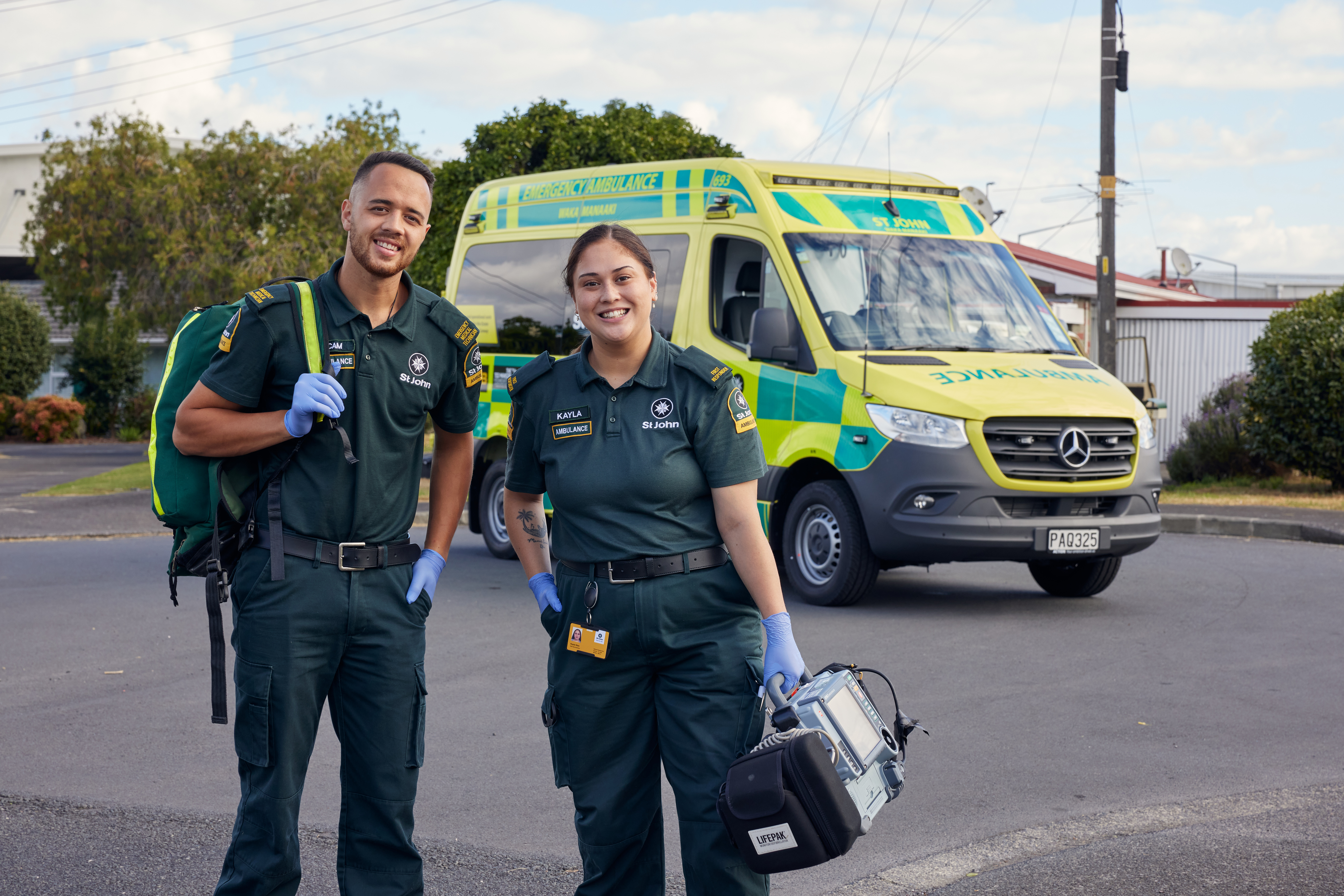
By Andrew Van Noordenburg
Lecturer in Paramedicine, School of Nursing, Midwifery & Paramedicine, Australian Catholic University
ACPIC24 poster prize winner
Many paramedics remember their first day in an ambulance. The consuming feeling of anxiety over who your preceptor may be; then, the relief once you realise the preceptor is engaged in your learning and provides a positive experience.
Or some paramedics may remember feeling stressed being a preceptor by not fully understanding how to perform the role effectively, particularly if your learner is having challenges. If one of these scenarios resonates with you, what skills, knowledge or attributes did you or your preceptor draw on to create a meaningful learning experience? What skills, knowledge or attributes were lacking? This article discusses these critical elements in the context of paramedic preceptorship with the aim of establishing an evidence base for preceptor education.
A paramedic preceptor is a clinical paramedic who works with a learner in a formal, time-bound partnership and helps to ensure the learner is safe and competent in their practice.(1,2) The preceptor achieves this by providing guidance, support, education and assessment.(1,2) The term ‘preceptor’ is interchangeable with others such as clinical ‘supervisor’, ‘instructor’ and ‘mentor’; however, ‘preceptor’ is the most appropriate title for the paramedic working with a learner due to the context of paramedic work and workplace relationship.(2)
Many health professions use preceptors to support learners as they transition to practice. Effective preceptors enhance learning opportunities,(1) and provide accurate feedback and assessment.(3) However, the benefits extend beyond education. Effective preceptorship can enhance patient care,(4) positively influence workforce retention, and increase learner satisfaction.(5) Equipping preceptors with the right skills and knowledge is critical to their success.
There is an abundance of paramedics in Australia who are considered ‘learners’ and require preceptorship. Paramedic learners can be students or graduates (of various clinical levels), paramedics returning to work, or those undertaking supervised clinical practice. As an indication, there are approximately 7,500 student paramedics undertaking clinical placements each year(6) in addition to the various learners already employed within an organisation. This means many paramedics must undertake the preceptor role despite some not being interested in preceptorship or suffering fatigue from a constant influx of learners.(1) Furthermore, many preceptors may lack the appropriate training to undertake the role.(1,2,7,8)
All paramedics have a role in supporting the development of the ‘next generation’ as outlined in the Paramedicine Board’s Professional Capabilities for Registered Paramedics.(9) Steps must therefore be taken to ensure all paramedics undertaking the preceptor role are effective in what they do. While some jurisdictional ambulance services provide preceptor training, this in-house training has been described as either short or inadequate and, in some cases, no training is provided at all.(1,2,7)
Moreover, the College’s recent workforce survey highlighted a bleak outlook of preceptor preparedness with only around 35% of Australian and Aotearoa New Zealand paramedics feeling ‘very well’ or ‘extremely well’ prepared for ‘clinical supervision’.(10) These findings not only indicate a significant gap in the support being provided to paramedics performing the preceptor role, but they highlight that the development of learners in the clinical setting is lacking. Further research is needed to identify the educational requirements for paramedic preceptors.
To address this gap, a scoping review was undertaken with the aim of strengthening the evidence base for paramedic preceptor education. The scoping review mapped the existing literature to identify the key knowledge, skills and attributes of paramedic preceptors. This information could then form a basis for a preceptor education program.
Multiple literature databases, paramedic-specific journals and Google Scholar were searched using a structured methodology.(13) Thirty-six articles were included in the review, which discussed various skills, knowledge and attributes for paramedic preceptors. Each were tabled and grouped with ‘like’ concepts and then frequency counting was undertaken to find the most commonly described. Utilising this process may provide an indication of the key elements to the paramedic preceptor role.
The findings showed that being a paramedic preceptor is an educative role and knowledge of learning and teaching approaches and methodologies is required. This component of the role was discussed in 97% of articles. The most essential were providing feedback (50% of articles discussed this concept), assessing effectively (39%), developing critical thinking (39%), coaching to facilitate learning (33%) and understanding adult learning theory (31%). Knowledge in learning and teaching practices have also been described as ‘core’ competencies for nursing, physiotherapy and pharmacy preceptors.(11,14)
Paramedic preceptors must also have effective interpersonal skills. Communicating effectively (50% of articles), including the ability to have difficult conversations and debrief incidents, was highlighted as pivotal to the role. Other interpersonal skills included the ability to build a positive relationship with the learner (47%) and support their socialisation in the workplace (29%). Interpersonal skills are critical for preceptors as many learners face clinical, emotional or social challenges as they enter or return to the workplace.(15) Having the right interpersonal skills will enable the learner to seamlessly assimilate into the workplace and help to improve their learning experience.
The literature also suggests a preceptor needs to have established their own clinical competence (36%) to be effective in their role. Preceptors were described as clinical ‘experts’ or ‘proficient’ and ‘confident’ in their clinical ability.(16,17) Learning opportunities can be maximised if a preceptor is clinically competent as they may have more confidence in ‘standing back’ to allow clinical exposure for their learners.(18) There is no clear time frame for when clinical competence is achieved as it varies from individual to individual. However, nursing literature states clinical competence can be obtained after two to three years of clinical experience.(19)
Other key elements to the paramedic preceptor role included being a role model (50%), counsellor (39%), critical thinker (33%), possessing an intrinsic desire for preceptorship, (33%) and having the capacity to provide a psychologically safe learning environment (33%). Interestingly, there is often overlap between these knowledge, skills and attributes, with many playing a supporting role in the development of another. As an example, knowledge of learning and teaching practices may increase a paramedic's capacity to perform the preceptor role. In turn, this may increase intrinsic desire and enthusiasm for preceptorship.(20) Additionally, the discussed interpersonal skills can ensure a psychologically safe learning environment for the learner and provide the basis for a preceptor to act as a counsellor.
Paramedics need opportunities to learn and develop the knowledge, skills and attributes identified in this scoping review. The findings provide an evidence base to develop a preceptor education program. Moreover, they can be used as selection criteria to identify appropriate preceptors. Further research is needed to identify if there are specific preceptor requirements for the individual learner groups i.e., student, graduate or intensive care paramedics.
References
Carver HM. The Paramedic Preceptor Experience: Improving Preparation and Support. Charles Sturt University; 2016 (cited 2024 Apr 30). Available from: https://researchoutput.csu.edu.au/en/publications/the-paramedic-preceptor-experience-improving-preparation-and-supp-3
Edwards DG. A grounded theory study of the preparedness of paramedics to undertake the role of preceptor in the clinical setting. University of Tasmania; 2018.
Knott GJ, Mylrea MF, Glass BD. Pharmacist and student evaluation of a preceptor training program in a regional Australian University: a multi-method study. BMC Med Educ (Internet). 2024 Jan 10;24(1):49. Available from: https://bmcmededuc.biomedcentral.com/articles/10.1186/s12909-023-04979-7
Snowdon DA, Leggat SG, Taylor NF. Does clinical supervision of healthcare professionals improve effectiveness of care and patient experience? A systematic review. BMC Health Serv Res (Internet). 2017 Dec 28;17(1):786. Available from: https://bmchealthservres.biomedcentral.com/articles/10.1186/s12913-017-2739-5
Aparício C, Nicholson J. Do preceptorship and clinical supervision programmes support the retention of nurses? British Journal of Nursing. 2020;29(20).
Council of Ambulance Authorities. Education. 2024 [cited 2024 Oct 1]. Available from: https://www.caa.net.au/education.
O’Meara P, Williams B, Hickson H. Paramedic instructor perspectives on the quality of clinical and field placements for university educated paramedicine students. Nurse Educ Today [Internet]. 2015;35(11):1080–4. Available from: http://dx.doi.org/10.1016/j.nedt.2015.06.002
O’Meara P, Hickson H, Huggins C. Starting the Conversation: What are the Issues for Paramedic Student Clinical Education? Australasian Journal of Paramedicine. 2014;11(4):1–8.
Paramedicine Board of Australasia. Professional capabilities for registered paramedics. 2018;(June):1–10.
Thyer L, Baldry S, Hernandez-Grande A, Sharafizadm Fleur, Aiello S, Howie G, et al. Australasian Paramedicine Workforce Survey. 2024.
Ryan CL, Cant R, Hughes L, Ahchay D, Strickland K. Core competencies for Registered Nurse preceptors: A mapping review of quantitative studies. Vol. 11, Nursing Open. John Wiley and Sons Inc; 2024.
Scott G, Change E, Gregennikov L. Using successful graduates to improve the quality of undergraduate nursing programs. Journal of Teaching and Learning for Graduate Employability. 2010;1(1):26–44.
Peters MDJ, Godfrey C, McInerney P, Khalil H, Larsen P, Marnie C, et al. Best practice guidance and reporting items for the development of scoping review protocols. JBI Evid Synth. 2022 Apr 9;20(4):953–68.
Bartlett AD, Um IS, Luca EJ, Krass I, Schneider CR. Measuring and assessing the competencies of preceptors in health professions: A systematic scoping review. BMC Med Educ. 2020;20(1):1–9.
Devenish S. Experience in Becoming a Paramedic: A Qualitative Study Examining the Professional Socialisation of University Qualified Paramedics. [Internet]. Vol. 7, Creative Education. Queensland University of Technology; 2014 [cited 2024 Apr 30]. Available from: https://eprints.qut.edu.au/78442/
Edwards D. Paramedic preceptor: Work readiness in graduate paramedics. Clinical Teacher. 2011;8(2):79–82.
Sibson L, Mursell I. Mentorship for paramedic practice: are we there yet? Journal of Paramedic Practice. 2010;2(5):206–9.
Gurchiek DJ. The meaning of ambulance preceptorship: Paramedics’ lived experience of being a field internship preceptor [Internet]. Capella University ; 2011 [cited 2024 Apr 30]. Available from: https://www.proquest.com/dissertations-theses/meaning-ambulance-preceptorship-paramedics-lived/docview/878167320/se-2
Benner PE. From novice to expert : excellence and power in clinical nursing practice . Commemorat. Upper Saddle River, N.J: Prentice Hall; 2001.
Ryan RM, Deci EL. Self-Determination Theory : Basic Psychological Needs in Motivation, Development, and Wellness.The Guilford Press; 2017.

Get unlimited access to hundreds of ACP's top courses for your professional development.
Join Now